
Frameworks for understanding impact at scale
Continuing in our series of articles on impact at scale, we look at six frameworks or models for understanding how to create impact at scale.

- SVA is researching one of the social sector’s biggest challenges in Australia: how to create impact at scale, and how can social sector leaders be better equipped to lead these changes.
- There are several established frameworks, methodologies and fields of practice on approaches to impact at scale that SVA reviewed for the project.
- This article summarises six frameworks that were frequently mentioned by sector partners and leaders in the research: Routes to Scale; The Water of Systems Change; Scaling Out, Scaling Up, Scaling Deep; What’s Your Endgame; Strong Field Framework; and Building Better Systems. Sources for these six frameworks are provided.
- SVA chose the Routes to Scale framework to anchor the work on impact at scale finding it a useful strategic tool in planning impact at scale for a number of scenarios, and at both an organisation and field level.
In a project funded by the AMP Foundation and the Paul Ramsay Foundation, SVA has been investigating one of the biggest challenges in the social sector – what it takes to create impact at scale and how to help equip social sector leaders in Australia in this endeavour.
In early September 2023, we held a summit to discuss with social purpose leaders our findings to date and will be sharing results in a paper due to be released later this year.
As part of this project, we started with a broad literature review of the different frameworks being used by social purpose leaders within Australia and overseas in their journey towards this aspiration.
There are several established frameworks, methodologies and fields of practice on approaches to impact at scale, including systems change, scaling organisations and programs, field building, and movement building. And there are many Australian forums, discussions and sector leaders investing efforts in this topic.
The six frameworks we review here were frequently mentioned by the sector partners and leaders we spoke with as part of this work. Although it is not possible to cover all the detail and nuance of these frameworks within these short summaries, they are intended to provide insight into why these frameworks are a valuable resource for social purpose leaders interested in impact at scale. We encourage you to access the source materials to build your understanding of these frameworks and see examples and case studies of how each framework can be used.
The six frameworks
The six frameworks are:
- Routes to Scale. This framework was developed by Social Finance, a UK not-for-profit established in 2007 that partners with government, the social sector and impact investors to find better ways of tackling social problems and improving the lives of people in need. You can access the framework at Social Finance, 2021, ‘Changing Lives, Changing Systems: Building Routes to Scale’. This was the model that we chose to anchor our work on impact at scale in for reasons given below.
- The Water of Systems Change. This framework was authored by John Kania, Mark Kramer and Peter Senge for FSG, a mission-driven consulting firm supporting leaders in creating large-scale, lasting social change. You can access the framework at John Kania, Mark Kramer & Peter Senge, FSG, 2018, ‘The Water of Systems Change’.
- Scaling Out, Scaling Up, Scaling Deep. This framework was authored by Darcy Riddell and Michele-Lee Moore for the J.W. McConnell Family Foundation and Tamarack Institute. It is based on insights and lessons gained by the J.W. McConnell Family Foundation’s ‘Applied Dissemination’ deliberate granting strategy to reframe approaches to replicating successful grant projects. You can access the framework at Darcy Riddell & Michele-Lee Moore, J.W. McConnell Family Foundation, 2015, ‘Scaling Out, Scaling Up, Scaling Deep: Scaling Innovation’.
- What’s Your Endgame. This framework was authored by Alice Gugelev & Andrew Stern, published in the winter 2015 Standford Social Innovation Review. You can access the framework at Alice Gugelev & Andrew Stern, Stanford Social Innovation Review, 2015, ‘What’s Your Endgame?’
- Strong Field Framework. This framework is authored by the Bridgespan Group for the Focus periodical publication of the James Irvine Foundation designed to spotlight selected issues, trends and challenges of the nonprofit sector in California. You can access the framework at Bridgespan Group, The James Irvine Foundation, 2009, ‘The Strong Field Framework’.
- Building Better Systems. This framework was authored by Charles Leadbeater and Jennie Winhall as part of the System Innovation Initiative within the Rockwool Foundation. The System Innovation Initiative connects knowledge and practice on system innovation to leaders, innovators and entrepreneurs who want to have more systemic impact and meet big, shared societal challenges in new ways. You can access the framework at Charles Leadbeater & Jennie Winhall, The Rockwool Foundation, 2020, ‘Building Better Systems: A Green Paper on System Innovation’.
A look at the frameworks
Here we outline for each of the frameworks, three questions:
- What does the framework say?
- What is the framework’s intended use?
- How have we found it useful?
1. Routes to Scale
You can access the framework at Social Finance, 2021, ‘Changing Lives, Changing Systems: Building Routes to Scale’.
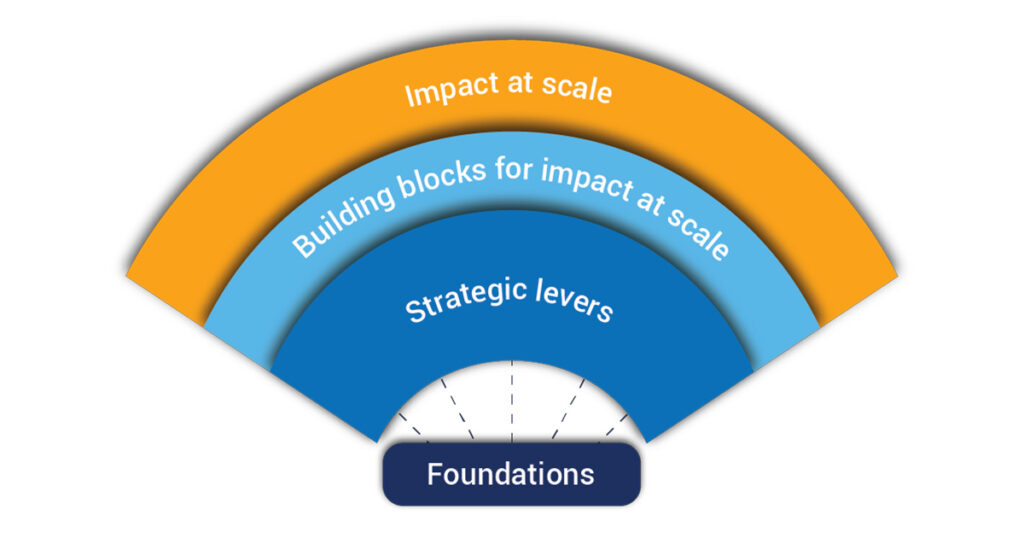
What does the framework say?
The Routes to Scale framework defines impact at scale as ‘the lasting change in people’s lives and society we see when products, services or practices sustainably expand their reach, when systems embed change or when society and culture shift their perspective’.
The framework is organised in three layers:
- Building blocks for impact at scale: the outcomes that need to be achieved to build towards impact at scale.
- Strategic levers: the different ways to achieve the outcomes. The framework puts forward a set of strategic levers, which can be pulled using many different approaches.
- Foundations: three core elements, strong partnerships, consistent funding, and a clear story, which are key for any efforts towards impact at scale.
Unpacking the building blocks for impact at scale
Building blocks are meaningful achievements in building towards impact at scale that can serve as goals to track and measure progress. Many different individuals and organisations can contribute to putting them in place. Building blocks do not come in a given order and often reinforce one another. The framework identifies the following building blocks:
- Widespread solution delivery
- Existing sectors adopt new ways of working
- New or changed funding
- Accountability or incentives shift
- Supportive policy, legislation, or regulation
- New public conversation.
Unpacking the strategic levers
Strategic levers are ways to put the building blocks in place. These levers often sit across organisational boundaries. The framework notes that progress towards impact at scale is most effective when organisations collaborate to identify the levers that are most relevant to their desired change and how to work together to influence them. There are 18 strategic levers identified, including:
- Create supply and demand
- Unlock capital
- Expand the organisation
- Develop talent
- Build the evidence base
- Create feedback loops.
There is no limit on the number of strategic levers that can or should be adopted to work towards the building blocks. This reflects the potential for innovation and evolution in how impact at scale is achieved.
What is the framework’s intended use?
Social Finance acknowledge that impact at scale is hard, complex, without a typical linear path. They have found that those working towards this aspiration ‘often talk at cross purposes and that there are not common definitions’ around their aims. The Routes to Scale framework offers a definition of impact at scale and ‘provide(s) a guide to help navigate this complexity’ by ‘help(ing) figure out different routes towards change’.
How have we found it useful?
The Routes to Scale framework is a useful strategic tool in planning efforts towards impact at scale. It encompasses a wide variety of pathways, including those typically used in systems change, scaling programs to expand their reach, field-building, advocacy and social campaigning. The broad range of strategic levers make it relevant across a range of scenarios, at both the organisation and field level.
For these reasons, we have anchored our work on impact at scale in the Routes to Scale framework.
2. The Water of Systems Change
You can access the framework at John Kania, Mark Kramer & Peter Senge, FSG, 2018, ‘The Water of Systems Change’.
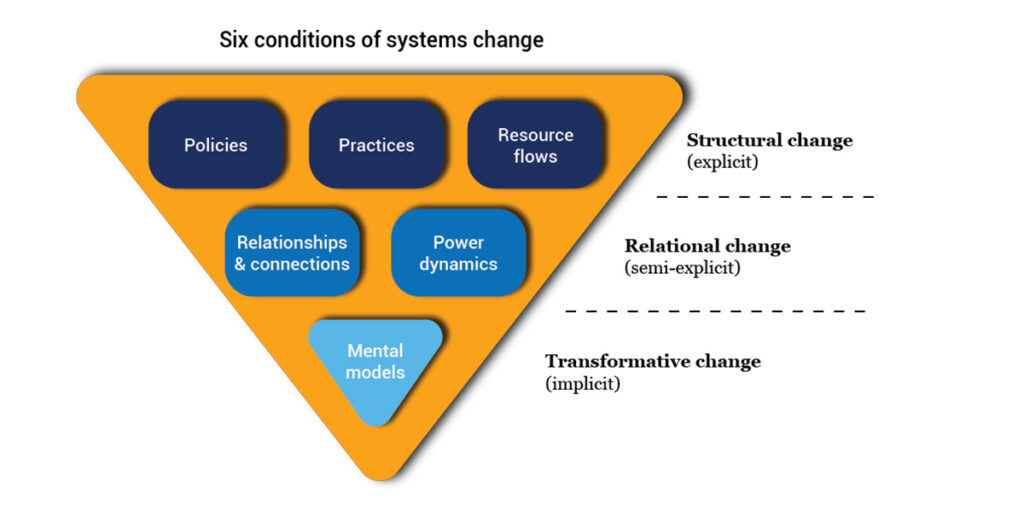
What does the framework say?
The Water of Systems Change framework considers how to create systems change by shifting the conditions that are holding a social problem in place. Though the term impact at scale is not explicitly mentioned, systems change is considered a key approach to working towards large-scale and lasting social change.
The framework identifies six interdependent conditions that hold a problem in place. Some conditions and changes to them are easier to identify than others. Structural changes like new policies, practices, or ways of allocating resources are the easiest to identify. Relational changes like building networks and shifting power dynamics can be detected but are less explicit. Lastly, transformative change like shifting deeply held ways of understanding the world are often invisible. The framework emphasises that for surface level structural changes to last, they need to be reinforced by relational and transformative changes that are harder to see.
What is the framework’s intended use?
The authors provide a framework that intends to clarify ‘what it means to shift conditions that are holding a social or environmental problem in place’. Their aim is to ‘create an actionable model’ for those interested in creating systems change, acknowledging that systems change can be a concept that is ‘hard to grasp and apply’.
How have we found it useful?
This framework provides a useful mental model to understand and identify the systemic conditions that often hold a social problem in place. In considering approaches to impact at scale, mapping these conditions, and the extent to which they are presently barriers or enablers to impact at scale, can be a useful process to identifying the pathways or levers required.
3. Scaling Out, Scaling Up, Scaling Deep
You can access the framework at Darcy Riddell & Michele-Lee Moore, J.W. McConnell Family Foundation, 2015, ‘Scaling Out, Scaling Up, Scaling Deep: Scaling Innovation’.
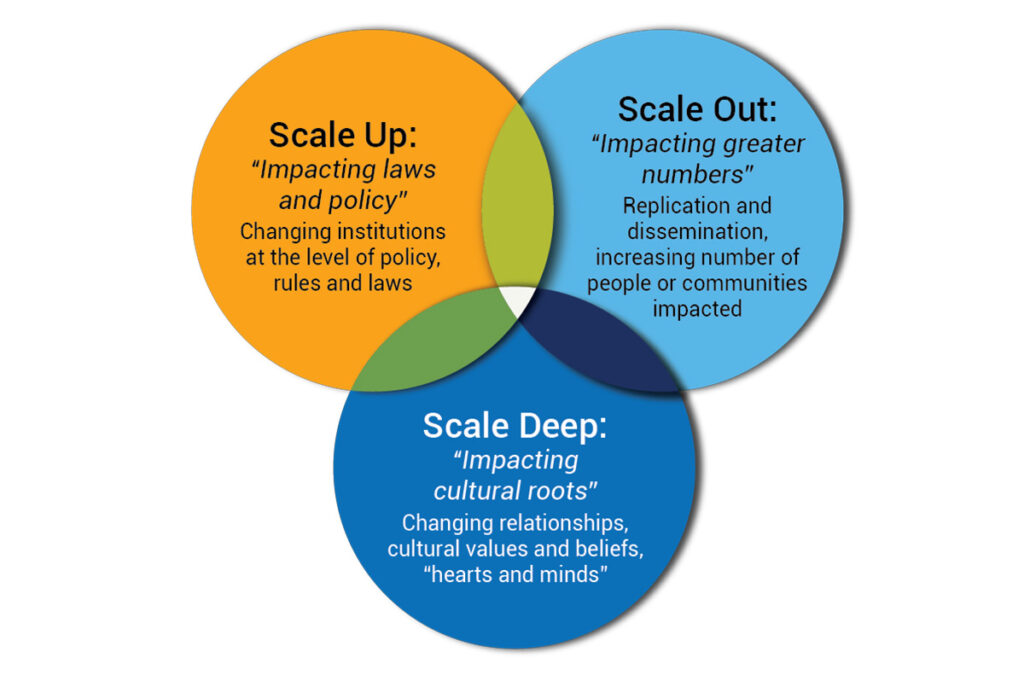
What does the framework say?
The Scaling Out, Scaling Up, and Scaling Deep framework unpacks what it means for social purpose organisations to achieve greater social impact, which is more complex than simply scaling their organisation. Though the term impact at scale is not used within the framework, the three approaches outlined are all different avenues to scaling impact.
The framework puts forward three approaches to scaling impact:
- Scaling Out: impacting greater numbers by growing a successful initiative or spreading principles to be adapted in new contexts.
- Scaling Up: impacting law and policy so that successful initiatives are enabled and protected across society.
- Scaling Deep: impacting individuals, relationships, communities, and cultures by spreading big cultural ideas, storytelling, and investing in transformative learning.
The framework also provides five, key cross-cutting scaling strategies associated with scaling impact.
What is the framework’s intended use?
The framework’s typology of Scaling Out, Scaling Up and Scaling Deep arose from the actual pathways adopted by grantees in working to scale their impact. Grantees often found that Scaling Out alone, was not able to address the systems that hold social problems in place. Many shifted towards impacting laws, policies, institutions, communities, and cultural ideas in order to better scale their impact.
The framework highlights the ‘complexities and complementary nature of the strategies involved in advancing large systems change’. It intends to ‘open up new avenues for non-profit leaders to consider and illuminat(e) the role of funders and conveners in amplifying the potential impacts of social change initiatives.’
How have we found it useful?
The Scaling Out, Scaling Up, Scaling Deep framework highlights that creating large-scale and lasting social change often requires more than growing a product or organisation. Spreading big cultural ideas, shifting laws, policies and practices, and investing in transformative learning are some of the broader ways to contribute to impact at scale and shift the underlying systems holding social problems in place. It is important that social purpose leaders appreciate this breadth and diversity of pathways to creating social impact, which encompass more than scaling organisations.
4. What’s Your Endgame
You can access the framework at Alice Gugelev & Andrew Stern, Stanford Social Innovation Review, 2015, ‘What’s Your Endgame?’
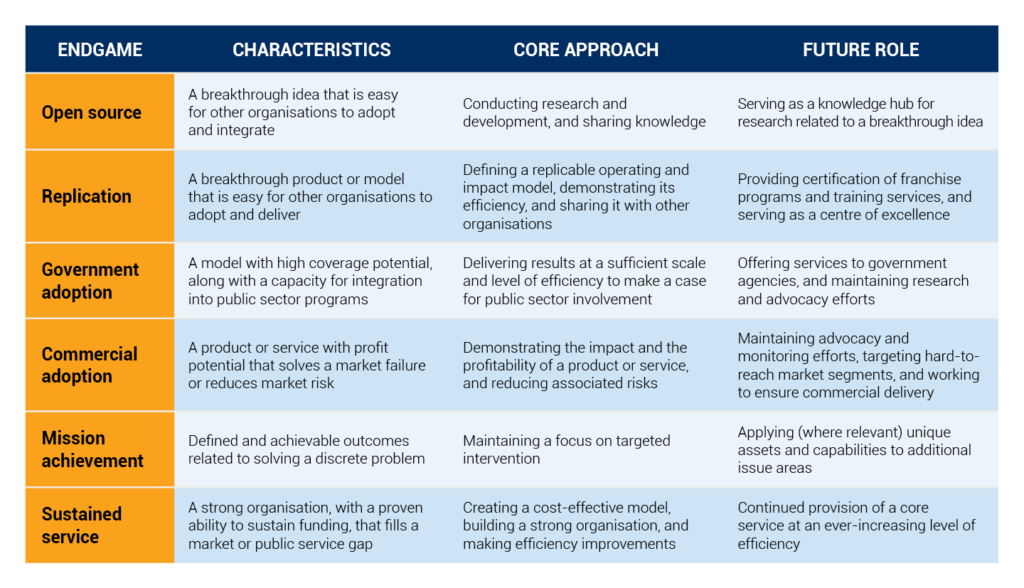
What does the framework say?
The framework in What’s Your Endgame argues that social purpose organisations should not solely focus their efforts on how to grow their organisation or initiative but instead measure their success by how they are helping to meet the total addressable social issue. Though the framework does not use the term impact at scale, it suggests that social purpose leaders focussing on their ‘endgame’ for social impact can maximise their ability to achieve large-scale social change.
There are six endgame options highlighted, including spreading a breakthrough social innovation through open source methods, replicating it via other organisations, seeking government or commercial adoption, or creating a strong organisation that can effectively provide sustained service delivery. Each option shapes the focus, future role, and budget needs of organisations. Notably, most endgames do not require an organisation to continue growing its funding over time, as it is often challenging to secure sufficient capital to do this.
What is the framework’s intended use?
The authors importantly note that ‘the scale of an organisation… does not necessarily equal the scale of its impact’. They urge non profit leaders to shift from considering how they should scale up, and instead ask what their endgame is in addressing a social problem. Defining the endgame early can guide an organisation’s path and lead to greater impact, despite the known challenges with seeking increased and sustained funding.
How have we found it useful?
The What’s Your Endgame framework encourages social purpose leaders to consider the breadth of options to scaling their impact, many of which are not reliant on organisational growth or increased organisational funding. This framework is a helpful tool for any organisation considering how to expand the reach of their social innovation, in light of a difficult funding landscape.
5. Strong Field Framework
You can access the framework at Bridgespan Group, The James Irvine Foundation, 2009, ‘The Strong Field Framework’
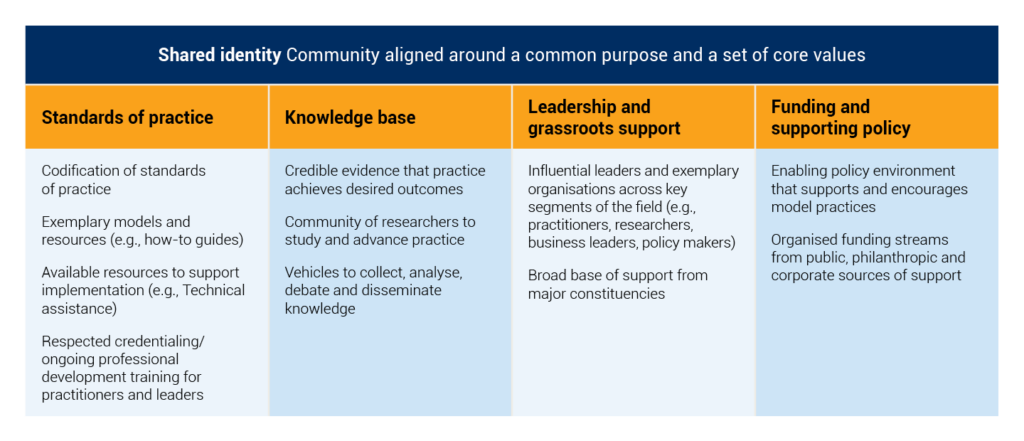
What does the framework say?
The Strong Field Framework recognises that social change requires a critical mass of organisations and individuals aligned and working effectively as a field. Though the framework does not explicitly mention impact at scale, it provides that field building is a critical strategy for social change and those committed to large-scale impact need to be intentional around strengthening their fields.
The framework outlines five key components of a field that can be assessed to identify strengths and weaknesses. Having a shared identity is the foundation for any field. A field’s effectiveness is further shaped by its standards of practice, knowledge base, leadership and grassroots support, and funding and policy environment.
What is the framework’s intended use?
The authors aim for the framework is to ‘help other foundations and nonprofits to assess the strengths and needs of the fields they seek to build, and to prioritise their efforts and investments’. They note that the framework has also helped them ‘become more strategic in (their) field-building work’. Included within this framework is a toolkit describing the steps to be taken to assess the field you are working within.
How have we found it useful?
The Strong Field Framework shows that impact at scale requires many individuals and groups to work together effectively. Its focus on improving a field’s infrastructure to enable the efforts of field players is an important mindset when working towards impact at scale. Further, having clarity over the defined field, its key practices, knowledge base, funding and policies can enable social purpose leaders to think holistically about the levers available to improve the collective’s impact on a social issue.
6. Building Better Systems
You can access the framework at Charles Leadbeater & Jennie Winhall, The Rockwool Foundation, 2020, ‘Building Better Systems: A Green Paper on System Innovation’.
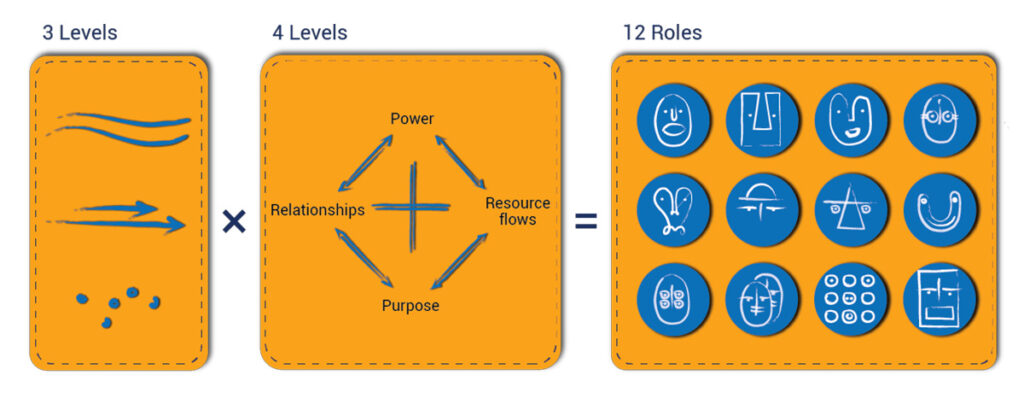
What does the framework say?
Building Better Systems is a framework that promotes system innovation as a response to systemic challenges and opportunities. Though the framework does not use the term impact at scale, system innovation, or the development of new and better social systems, is a key approach to creating large-scale and lasting social change.
System innovation encompasses both the fixing of an existing system holding a social issue in place, and exploring and creating a new, improved system around a social issue. The framework provides that system innovation occurs at three levels:
- Macro: the ‘landscape’: values, ideas, demographics, and economic context
- Meso: the ‘regime’: laws, rules, and norms
- Micro: ‘niche’ innovations: new practices, technologies, and ways of living
System changes are then unlocked by working with a set of four system keys: Purpose, Power, Resources, and Relationships. Often social problems are held in place because these system elements are locked together and mutually reinforcing.
System innovation requires people to work together across twelve different system innovation roles. Together these roles open up the possibility of systems change and the creation of a new, improved system. The four leading roles are entrepreneurs, inside-outsiders who open the system up to external ideas, conveners, and commissioners.
What is the framework’s intended use?
The authors describe their work as ‘the start of (their) effort to create practical frameworks, methods and tools for system innovation’. They focus on three areas:
- ‘To turn knowledge about how systems have changed into practical knowledge of how to make systems change on purpose.’
- ‘To create new, better and different systems not just to improve existing systems.’
- ‘To show how people can shape systems, not just be shaped by them.’
How have we found it useful?
The Building Better Systems framework highlights that systems change is about more than improving existing systems – it also involves shaping new and better systems. It is a useful frame for impact at scale when thinking about the broader structural levels and elements that hold a social issue in place and what might be required to overhaul those systems. The four leading roles also align with our views on the key roles that can be adopted when working towards impact at scale.
Which framework we chose to base our work on and why
Throughout our work so far, we have found the Social Finance Routes to Scale Framework as a useful tool to help frame the topic of impact at scale. Specifically, it outlines a broad set of outcomes required to achieve impact at scale alongside a set of key strategic levers and pathways.Through our consultations with sector leaders in this project, we heard alignment that Routes to Scale encompasses the variety of activities and pathways collectively required to drive impact at scale. It includes systems change, scaling, field-building and social campaigning approaches, whilst providing a planning tool for social purpose leaders to map and assess their efforts towards the building blocks of impact at scale.
Social Ventures Australia wishes to thank PRF Foundation and the AMP Foundation for supporting this research.
The contents of this work is for research purposes and to critique various impact at scale models published. It is for information purposes only. The publisher, Social Ventures Australia Limited, a not-for-profit entity.
The cited works contain copyright material owned by a third party, the use of which has not always been specifically authorised by the copyright owner. Notwithstanding a copyright owner’s rights under the Copyright Act, the publisher is relying on the fair dealing/fair use provisions of the law to reproduce a reasonable portion of the copyrighted work for the purpose outlined above.
The publisher has attributed copyrighted materials and where cited, has not modified the copyrighted material.
This material can be reproduced under Creative Commons Attribution-NonCommercial-NoDerivatives 4.0 International (CC BY-NC-ND 4.0) licence.





